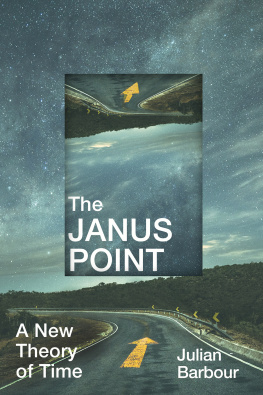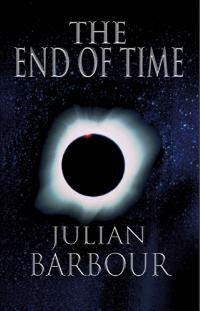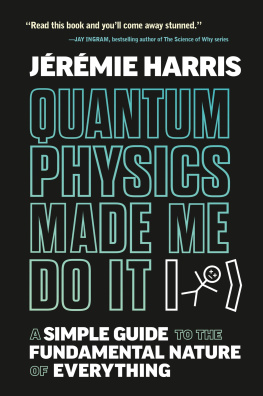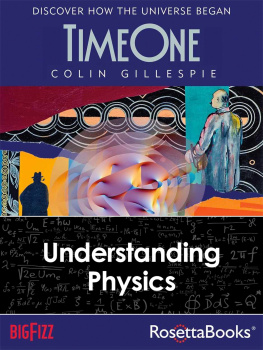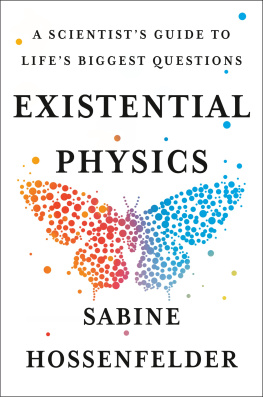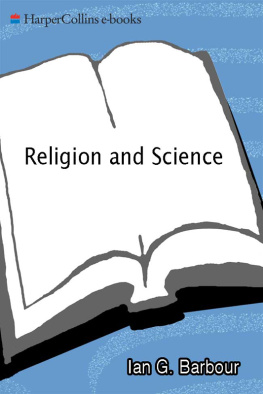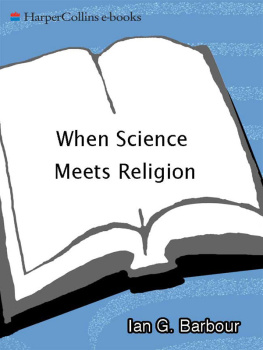

Julian Barbour
THE JANUS POINT
A New Theory of Time

CONTENTS
ABOUT THE AUTHOR
Julian Barbour is a former Visiting Professor in Physics at the University of Oxford and author of the highly regarded The Discovery of Dynamics and the bestseller The End of Time. His papers have been published in the worlds most prestigious scientific journals, including Nature, Proceedings of the Royal Society and Physical Review Letters and he has made numerous appearances on national radio, television and in various documentaries. The Janus Point is his first book in twenty years and the culmination of five decades work.
In memory of my wife, Verena, and our daughter Jessica
LIST OF ILLUSTRATIONS
Maxwellian velocity distributions for a monatomic gas in three dimensions.
Two possible behaviours of the square of rms when the energy is non-negative.
Janus as depicted on a Roman coin.
A typical history of the minimal model.
The one-pasttwo-futures interpretation.
The same triangle at different positions in Newtons absolute space.
Infinitesimal actions: Newtonian (left) and Machian (right).
Horizontal and vertical stacking.
Arbitrary and CMC slicings of spacetime.
Particle distributions with the same shape and complexity.
Visibly dissimilar particle distributions with different complexities.
Complexity growth in 3-body and 1000-body simulations.
The shape sphere for three equal-mass particles.
Three-body dynamics in space and on the shape sphere.
Darts thrown by a blindfolded creator at shape space.
Definition of shape entaxy and its decrease.
Three planar central configurations of eight equal-mass particles.
Near-maximal central configuration of 500 equal-mass points with slice through it.
Homothetic (dashes) and nonhomothetic (solid curves) total collisions compared.
Two 3-body shape spheres viewed from above their north pole.
Unequal-mass shape sphere with curve of steepest descent and Newtonian solutions (shown in detail on the right) splaying away from the eigendirection with the larger eigenvalue.
Equal-mass three-body (left) and Bianchi IX (right) shape spheres.
Bianchi IX (white) and Bianchi I (black) solutions.
Poisson (left) and glassy (right) distributions of point particles.
The central configuration shown earlier has a very uniform distribution.
Earth receiving high-energy solar photons and emitting low-energy photons.
PRAISE FOR THE JANUS POINT
Julian Barbours The Janus Point is simply the most important book I have read on cosmology in several years. He presents a novel approach to the central question of why time has a direction, providing a serious alternative to contemporary thinking. With a rare humanity and a perspective based on a lifetime of study of the history and philosophy of cosmology, Barbour writes a book that is both a work of literature and a masterpiece of scientific thought.
LEE SMOLIN, author of The Trouble with Physics
Julian Barbour is well known for his brilliant study of physics history, The Discovery of Dynamics. The Janus Point includes a similar history of thermodynamics, statistical mechanics, and the arrow of time. But for me the main point of the book was to show history-in-the-making. His shape dynamics is a project to recast the foundations of all of cosmology, gravity, thermodynamics, and the arrow of time. The book has given me a lot to ponder. As Gauss said of Riemanns habilitation lecture, [it] exceeded my expectations.
BILL UNRUH, professor of physics at University of British Columbia
Julian Barbour has no peer when it comes to explaining scientific ideas in a way that is accessible without being simplistic. For good measure he has a talent for using quotes from Shakespeare and other literary sources in a manner that actually helps to elucidate key points. In The Janus Point he tackles subject matter that is notoriously challenging even to scientists, and explains it in a way that gave me new insights and understanding even though I studied these topics in a classroom a long time ago. This is a fitting sequel to his earlier work and helps to pull together several big ideas that some of us have been watching with fascination for decades.
NEAL STEPHENSON, author of Snow Crash
By abandoning the prejudice that particles (atoms, stars ) are confined in a box, Julian Barbour has discovered an unexpected and remarkably simple feature of Newtonian dynamics. It is the basis of his seductive and eloquently presented explanation of the history of the universe, even time itself. Is his cosmology correct? Time will tell.
MICHAEL VICTOR BERRY, Melville Wills Professor of Physics (Emeritus) at Bristol University
Julian Barbours infectious enthusiasm for the big ideas in physics is addictive. He has a complete mastery of the history of ideas yet a remarkable lightness and clarity in explaining what are profound concepts. The Janus Point is controversial and gripping, an extraordinary introduction to his view of the universe.
PEDRO G. FERREIRA, author of The Perfect Theory
Julian Barbour is a profound and original thinker, with the boldness to tackle some of natures deepest problems. He is also a fine writer, and this renders his bookdespite its conceptual depthaccessible to anyone who has pondered the mysteries of space and time. Its a distillation of the authors prolonged investigations, and the insights that he offers deserve wide readership.
MARTIN REES, author of On the Future
PREFACE AND ACKNOWLEDGEMENTS
THIS BOOKS ORIGINAL SUBTITLE was A New Theory of Times Arrows and the Big Bang. That is what its substance remains, but I was happy to accept the suggestion of TJ Kelleher, my editor of the US edition, and adopt its present shorter form. I think there is warrant for it. The big bang not only gave birth to time but also stamped on it the eternal aspect of an arrows flight. Thus the two together do amount to a new theory of time. Please note the indefinite article in the subtitle. Nothing in science is definitive. Hypotheses are proposed and tested. Science progresses when, through precise experiment and good observation, predictions are either confirmed or refuted. I believe the proposed explanation of times arrows is as secure as is the long-established expansion of the universe, but some radical ideas about the big bang, which matured late in the writing of the book, are definitely speculative. I have nevertheless decided to include them because they do represent what seems to me, now that they have been recognised, to be an almost inevitable bringing together of everything else.
This is a very personal book in which I have tried to combine established science of the cosmos with new ideas, but I also include here and there my own reactions to existence in the universe and wonder at its nature. How is it that time has not only created the physical world of atoms and galaxies but also poets, painters, and composers? The works of Shakespeare have been a great joy in my life. You will find him quoted explicitly in a dozen or so places, but for buffs of the Bard I have also, now and then and unattributed, smuggled in from his plays and sonnets a half line or even a single word. I hope you will get a little pleasure if you spot these purloined feathers. The final chapter is not quite an epilogue because it brings in discussion of the arrow we experience most directly, that of the passage of time. I think this is intimately related to the greatest mystery of allthe gift of consciousness. Dont expect any answer to the mystery, but perhaps I can offer illumination of one of its aspects. Otherwise the chapter is an attempt to identify what it is in the mathematics of the universe that is manifested in art. It must be there since all great art has a unique structure, and structure is the very essence of mathematics.
Next page
